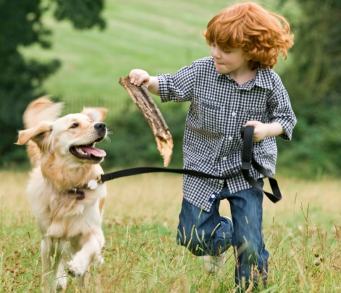Tips for Safe Baby Play with Pets
0 comments
Pets can be a friend of the owner. Although it was benign still we must be careful. Do not remove the supervision of your children with pets.
"Young children have a high risk of injury due to pet. They like to play with the noisy, even kicking and hitting. They did not mean to hurt, but it can trigger stress in pets." Genevieve said Reisinger, a specialist in animal behavior, such as quoted by Today's Parent.
According to Reisinger again, children aged under five can not understand or remember the specific instructions you give about how to behave when playing with animals. So, check out a few steps below so your child can play safely with pets:
1. Supervise
Young children always consider their pets to behave. However, animal behavior is very difficult to predict. A small child in Vancouver, Canada had been attacked by a dog brother who always behave well. Though the child accidentally fell and hit the dog.
"Even a gentle dog can bite if they feel sick or scared," said Rebecca Ledger, an ethologist (specialist in animal behavior) in Vancouver.
Supervise children playing with pets is the best way to prevent the accident. "Pets should not be left alone to play with the kids. Even hamsters can bite," said Reisinger.
2. A good introduction
Kenalkanlah your child with a pet in a good way. "Dudukkanlah your child in the seat when introduced with pets. Do not forget to give the rope and cover the pet's snout. It can mengontol pet movement," said Ledger.
Why do children have to sit? Children usually like to run-larian. If time is introduced in pets, he ran, most likely, he could be pursued (if the pet dog) and the injured. "It's the nature of dogs to chase something moving in front of him," said Ledger again.
3. Give your own place
You must teach the dog to go to the cage when he looks from stress. "Dogs should always have a safe and comfortable cage. They can remain silent in the cage when feeling stressed," says Reisinger. Usually the cat easily find safe places them under the bed and closet.
Teach your child not to disturb the pets that are stressed. Reisinger suggested, you can set limits to protect your child and never stopped watching.
4. Know your animal gestures
"Dogs communicate with each movement of their bodies. We're watching, pay attention and respond to them. Get to know every move to avoid an attack, because one of the early signals given dog can be bad," said Reisinger.
Ledger added that when a small dog can be tolerant with the employer's behavior was a kid. But as adults, the dog more difficult to accept the employer's attitude. In addition, older dogs can also be affected by the disease. They can be blind and deaf.
5. Animal ethics
Who says animals can not be taught ethical? When you see someone with a dog, hold your child's hand. Ask for permission to feed the dog. Let the dog moves toward the child, not the children who approached the dog. If the dog looks friendly, show the child how to gently rub the neck, chin or along the back of the dog. Do not touch eyes, ears and the top dog's head.
6. Anticipation accident
What if your child is bitten or scratched? If the skin tear, the child must be taken to the doctor. There is always a risk of infection and need antibiotics. Cat teeth and claws at most contain many germs.
While maintaining full veterinary risk, Ledger feels that raising animals has benefits for children. "Research shows that pets help children learn empathy and responsibility, and can reduce the risk of some diseases and allergies. You only need to manage the situation carefully," he said.



